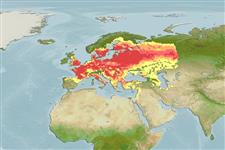Classification / Names
Common names from other countries
Main reference
Size / Weight / Age
Max length : 45.5 cm TL male/unsexed; (Ref. 88166); common length : 20.0 cm TL male/unsexed; (Ref. 556); max. published weight: 1.0 kg (Ref. 30578)
Length at first maturity
Lm ? range ? - ? cm
Environment
Freshwater; brackish; demersal; potamodromous (Ref. 51243); depth range 0 - ? m
Climate / Range
Temperate; 4°C - 20°C (Ref. 2059), preferred ?; 65°N - 40°N
Distribution
Europe and Asia: North, Baltic, White, Black (south to Rioni drainage) and Caspian Sea basins, Atlantic basin southward to Adour drainage (France; possibly introduced southward of Loire) and Mediterranean basin in France (Hérault and Rhône drainages). In Aral, Marmara and Anatolian Black Sea basins west of Ankara. Naturally absent from Iberian Peninsula, Italy, Adriatic basin, Crimea, Great Britain (except southeast), Scandinavia north of Sundsvall (Sweden) and 65° N (Finland). Locally introduced in Spain and northeastern Italy; in France, apparently introduced in smal coastal drainages of Var.
Countries | FAO areas | Ecosystems | Occurrences | Introductions
Short description
Dorsal
spines
(total): 3;
Dorsal
soft rays
(total): 8;
Anal
spines: 3;
Anal
soft rays: 19 - 22;
Vertebrae: 39 - 40. The only species of the genus which can be diagnosed from similar species of genera Ballerus, Blicca and Vimba by having the following characters: mouth sub-inferior, which can not be extended as a tube; scales on lateral line 43-46 + 2-3 ; anal fin with 19-23½ branched rays; eye diameter about equal to snout length in individuals larger than 10 cm SL; pharyngeal teeth 2,5-2,5; and orange or reddish base of paired fins (Ref. 59043). Caudal fin with 17-19 rays (Ref. 2196).
IUCN Red List Status (Ref. 115185)
Threat to humans
Harmless
Human uses
Fisheries: minor commercial; aquarium: public aquariums; bait: occasionally
Tools
Special reports
Download XML
Internet sources
Estimates of some properties based on models
Phylogenetic diversity index
PD50 = 1.0000 many relatives (e.g. carps) 0.5 - 2.0 few relatives (e.g. lungfishes)
Trophic Level
3.2 ±0.0 se; Based on diet studies.
Resilience
Medium, minimum population doubling time 1.4 - 4.4 years (K=0.10-0.27; tm=3-4)
Vulnerability
High vulnerability (65 of 100)
Price category
